More than just grand style
Chemnitz University researcher Frank-Lothar Kroll examines Saxon’s rulers in ZDF documentary – airdate: July 16, 2017, 11.30 p.m.
-

Prof. Frank-Lothar Kroll, historian at Chemnitz University of Technology, researches among other things on Saxon’s history. In the ZDF documentary he categorizes Saxon’s rulers. Photo: Screenshot from the TV show
Once upon a time they were the most powerful family and ruled for over 800 years in the middle of the German Empire – longer than any other dynasty: Saxon’s rulers from the Wettin family. The ZDF airs the documentary “Sachsens Herrscher” (Saxon’s Rulers) on July 16, 2017, at 11.30 p.m. As expert Prof. Frank-Lothar Kroll, Head of the Professorship of European History of the 19th and 20th Century at Chemnitz University, classifies and arranges the rulers and events in order. But that the Chemnitz historian stands in front of the camera is no coincidence. “As I have published between 2013 and 2016 three books on Saxon subjects, the cooperation came into being,” explains Kroll. This had drawn the attention of the editors to Kroll as an expert.
The documentary is a TV format with a mix of play scenes and expert interviews which Kroll thinks is suitable to introduce historical subjects to laypersons, in particular, as the content is scientifically and qualitatively ensured. “The play scenes bring the subject to life even for non-experts. And they re-narrate the rich history of Saxony in an exciting way”, says Kroll. The Saxon-expert himself deems the subject highly relevant – especially from an intercultural and European perspective: “Poland and Saxony were united for almost 70 years in the 18th century. This has left traces behind and made Saxony a cultural landscape right in the middle of Europe”, urgently emphasizes the historian. For hundreds of years, Saxony was the bridge between West and East. “This is something to keep in mind”, says Kroll.
From the late Middle Ages to Baroque
The documentary “Saxon’s Rulers” in the television series ZDF History shows the complex inheritance of Saxon’s rulers. Among them are electoral prince Friedrich der Weise, historically known as patron of Luther. Or August der Starke, who loved beautiful women as much as the beautiful arts and became the epitome of baroque’s pomposity. But the Saxon rulers of the Wettiner family did not remain in memory as warlords or conquerors but as patrons of the arts and “cultural princes”: August der Starke became King of Poland and laid the foundation stone for the international standing of the Dresden Art Collections. Karl August von Sachsen-Weimar-Eisenach brought Goethe into his homely city of residence and transformed the hick town Weimar into the center of German culture. But at this time, there were already other German dynasties that played on the big stage of politics. The sentence of the last Saxon King, Friedrich August III, who had to vacate his throne in 1918 became a saying: “Na, dann macht doch euren Dreck alleene!” (Well, then do your sh** by by yourselves!). Even today the tracks of the Wettiner family remain visible in many places in Saxony, Saxony-Anhalt, and Thuringia.
Further information are available from Prof. Frank-Lothar Kroll, Professorship of European History in the 19th and 20th Century at Chemnitz University, email: frank-lothar.kroll@phil.tu-chemnitz.de, phone +49 371 531 33922
Note: The documentary is available in the online media library of the ZDF: http://bit.ly/2u0BO6I (german)
Matthias Fejes
24.07.2017




